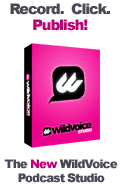The truth is that Microsoft made extensive changes between XP and Vista for how some sound processing is handled by Windows. Unfortunately, some of the coolest features of WildVoice Studio (recording your voice while playing a background track, playing multiple sound effects into a single recording, etc.) do not work on Vista. We designed WildVoice Studio specifically for these features, so WildVoice Studio requires much more work than a simple patch to be Vista compatible.
We started building this site and the software in the summer of 2005 and got it working pretty well by the end of 2006. We were never a big company. We never had venture capital or "other peoples' money" to spend. We were three guys who quit our day jobs with a dream of building an easy to use podcast creation and publishing system that would run as an online community. Needless to say, we're still not a big company. We've spent more of our own money building the software, building the site, and keeping this site running than I'd like to admit. So far, we still provide the software and site for free, and honestly, our advertising revenue has been insignificant.
It has been a thrill for me to see people post shows to the site, especially shows created with WildVoice Studio. But the truth is that the site never developed a large enough audience to sustain a business or even to sustain a vibrant on-line community. (There’s been lots of lessons learned which I’ll someday write up and post someday.)
After a glorious year and a half of building a dream, real life caught up with us. This was real life in the form of mortgage payments and orthodontist’s bills. So, about two years ago we had to all find real jobs again (real meaning a job with a salary). We had every intention of spending our nights and weekends updating the site and software and keeping WildVoice growing, but the realities of new careers, and personal and family challenges over the past two years, has made it almost impossible to do the type of engineering improvements and support work that WildVoice Studio and the site require.
So, here we are. It is 2009 and we aren’t ready for Vista, and we aren’t ready for IE 8, and I suspect we won’t be ready for the next version of Firefox. Should we roll up our sleeves and do an update for Vista and a site update? Realistically, a large market never developed for the type of casual podcaster that we envisioned would use our tools and site. I think the youtube video phenomenon captured the imaginations of our would-be podcasters and left us and our audio-centric peers with a small niche audience. So, by any logical decision process, there would be no return on our investment of doing the Vista updates. It would just be long nights and weekends away from our families after long days and weeks of working and commuting to our day jobs.
Do we still want to do the updates? Yes, we talk about it, and think about it and feel that we have unfinished business to complete. Have we committed ourselves to do the work? No, we haven’t committed ourselves to do the work.
So, I’d like to thank you our loyal users who continued to post shows on WildVoice.com and use our tools. Thank you for your persistence working around our bugs and site quirks. And, thank you for keeping that old XP machine running so you could still run WildVoice Studio.







